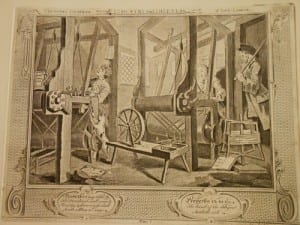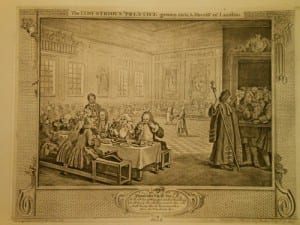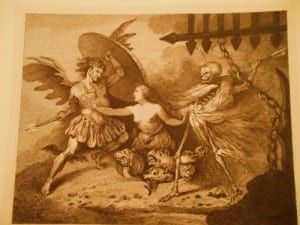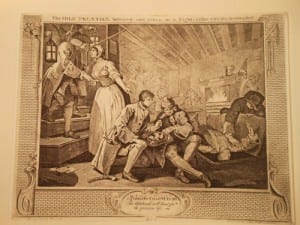Guest blog: Hogarth through American eyes
By Krisztina Lackoi, on 14 November 2012
Guest Blog by Rebecca Gleichenhouse
I’m a student at Wake Forest University in North Caroline studying History of Art. I’m in my third year and was very excited to have the opportunity to study in London for a semester. I’ve been interning at UCL Art Museum for the past month now and I’ve been doing a wide variety of activities within the museum. Other than the day-to-day work that I help with, my main project has been to sort through and catalogue new prints that have come in to the Museum through a major donation.
Thus far, I’ve looked through a box of about 70 William Hogarth prints, as well as material by little-known caricaturist C.J. Grant, and these have been interesting boxes to sort through because both artists criticise social and political aspects of their time. They made art not only for wealthy patrons, but made prints that were more affordable for the growing middle class. So far I’ve found Hogarth’s prints the most interesting – most of them are satirical images that criticise the lifestyle of different classes during his time.
One of my favourites from the Hogarth prints is Satan, Sin and Death, which depicts a scene from John Milton’s epic poem Paradise Lost. (The Tate have an unfinished oil sketch, unfortunately not on display, of the scene in their collections.)
On the left, Satan confronts Death, but they are blocked from each other by Sin in the middle, who is depicted as a nude woman. In this scene, Sin reveals to Satan that death is their son, conceived from their incestuous relationship. The reason I find this print so fascinating is because of the dramatic fashion in which Hogarth is able to depict the characters in this scene. There is such a dramatic sense of movement in the scene from Satan on the left drawing his arm back with his spear, to Sin in the middle with her arms sprawled trying to block Satan and Death. Although the other two characters show dramatic movement and are able to display the violence of the poem, my favorite figure in the scene is Death because although he is depicted as a skeleton figure he still somehow comes alive in the image.
Another set of prints that I really enjoyed having the chance to look through was Hogarth’s series Industry and Idelness (1747), which includes 12 separate print series.
- Industry and Idleness
It depicts the life of two different men, Tom Idle and Francis Goodchild, showing how their separate lives play out.Going through each print and seeing the progression of the story was extremely interesting because handling the prints in person really allowed me see how much detail Hogarth put into his different prints. These two characters represent two extremes of life in Hogarth’s time. One of Hogarth’s later series, this is a departure from earlier print series as he did not begin with paintings but made them directly into prints. Industry and Idelness is also different fr
om earlier series because it focuses on two separate characters, who are seen in the first image working at the same factory, but quickly lead separate lives due to the very different choices they make in life. Earlier work by Hogarth focused on only one character, and showed their decline in society.
 Close
Close




